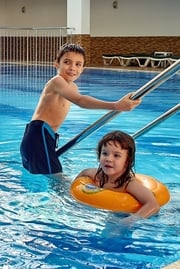5 Reasons Why Swimming is Beneficial to Your Child
Training your child how to swim is something you should consider doing. Yes, it can be challenging, but it is worth all the effort. Your kids can learn how swim from you or enroll them in swimming classes as early as when they are toddlers.
The earlier you can teach your child to swim, the better they get at it as they grow. There are several benefits of teaching your child how to swim early. This article reviews why swimming is beneficial to your child.
Swimming builds a child’s confidence.
It is common for children to be fearful of the water when swimming for the first time. Taking their first dip in the pool is often an unforgettable memory for most kids. However, after several trips to the beach or pool, kids eventually overcome their fears and learn how to swim. After learning how to swim, the feelings of accomplishment help build self-esteem and overall confidence in children.
What’s more, the self-esteem your kids gain from swimming can help them develop a positive attitude towards sports and other physical activities. Even better, the confidence your kids gain from overcoming their fear of water becomes helpful in social interactions later in life.
Enhances water safety
Swimming is an essential life skill everyone should know, including your little one. Reports from the Center for Disease Control and Prevention indicate that drowning is a major cause of death in children less than five years. Therefore, the most appropriate way to curb this menace is equipping your child with swimming skills. The best way how to teach kids to swim is by enrolling them in swimming classes.
Children who receive formal swimming lessons can overcome their fear of being in and around water much quicker. Besides that, they are taught water safety rules and techniques such as floating and treading in water and various swimming strokes. Formal swimming classes equip children with life-saving skills such as first aid and CPR. With regular practice, all these skills mold your child into a strong and efficient swimmer; therefore, you don’t need to panic whenever they are around water.
Learning to swim is also vital if you have a backyard pool. While children should never be left unattended, knowing how to swim can be lifesaving if they accidentally fall in.
Swimming is good for your kid’s health.
Swimming is an excellent way to keep your kids healthy and active all year long. The gentle body movements involved in swimming are beneficial to toddlers and infants. The water resistance they overcome when swimming helps in boosting muscle development. Swimming involves many muscle groups that you don’t engage when out of water. Swimming gives kids a whole-body exercise in a way not possible with other workout routines.
Swimming is an excellent physical exercise for kids because it is primarily impact-free, significantly reducing the risk of injury. Swimming at an early age strengthens joint muscles and helps to reduce joint stiffness. The endurance, confidence, and muscle strength your kids gain from swimming will come in handy when they try field and track events like soccer and athletics.
What’s more, swimming improves your kid’s cardiovascular health. The movements involved in swimming require the coordination of the lungs and heart to supply adequate oxygen and nutrients to the different muscle groups. Swimming regularly helps keep artery walls flexible and in good shape leading to improved blood flow throughout the body.
Improves memory and coordination
Introducing your kids to swimming at an early age is a great way to help them build balance and body coordination. Swimming often requires the coordination of many body organs during stroking movements. Water exercises enable kids and infants to develop balance without straining the body.
The extensive range of motions involved in swimming will help to improve joint mobility and flexibility in children. Your kid will learn how to maintain position using the buoyancy of water. Besides improving coordination, swimming enhances posture and reduces the chances of obesity in kids. Swimming lessons are also accessible for children with special needs.
Swimming also boosts a child’s mental development by enhancing the brain parts associated with learning, coordination, and memory. Your kids learning abilities improve as they master freestyle, butterfly, backstroke, and breaststroke swimming techniques. This mental development can lead to better performance in school.
Bottom line
Now that you know the benefits of teaching your kids how to swim, it’s time you get started on those classes. Learning how to swim is something your children will cherish and utilize all their life.
Related Reading:




 Katie Brenneman is a passionate writer specializing in education, mental health, family lifestyle and online safety. When she isn’t writing, you can find her with her nose buried in a book or hiking with her dog, Charlie. You can follow her on
Katie Brenneman is a passionate writer specializing in education, mental health, family lifestyle and online safety. When she isn’t writing, you can find her with her nose buried in a book or hiking with her dog, Charlie. You can follow her on 


